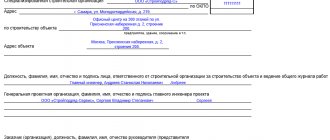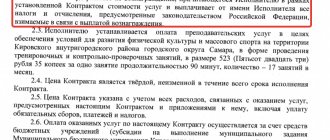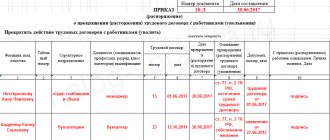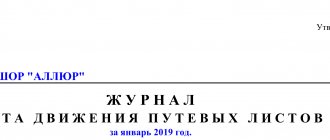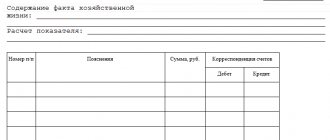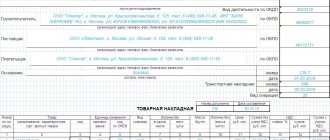The general work log in the KS-6 form is intended to record the work done and monitor the progress of their implementation. This is one of the main primary documents in the construction industry; all construction organizations must maintain it. The document contains the following information: deadlines for completing the work, materials used, comments from supervisory organizations, etc.
The work log in form KS-6 is a legally significant document, therefore all entries made in it must be confirmed. The magazine consists of a title page and 6 sections. It is filled out in accordance with the general requirements of office work.
If the log has expired, but the construction of the object has not yet been completed, the next log must be transferred to the construction organization. It should be marked with a serial number.
Read also: Inventory of unfinished construction
Who should fill out the document?
A representative of the contracting organization (boss, foreman, etc.) is responsible for filling out the journal in form KS-6. When the facility is put into operation, the completed log is handed over to the person responsible for receiving and storing documentation at the contractor.
The following entries can also be made in the journal:
- representatives of the developer company;
- representatives of the customer company;
- employees of the organization developing the project.
Form KS-6, which can be downloaded on the website, is maintained when carrying out work within the same construction site. The work performed can be of the same type or varied. Entries in the journal must be made from the very first day when construction began.
A sample of filling out the journal according to the KS-6 form will be presented below.
Where is this log used?
The magazine is used when carrying out construction and installation work and is used both by the contractor and by the organization carrying out construction for its own needs in an economic way. In fact, this is the main document for the primary accounting of stages and types of construction work , in which the contractor reflects the sequence, deadlines and conditions for the construction work, and which is created to control the stages of construction by the management of the contractor, the customer, as well as regulatory authorities (tax authorities, construction authorities supervision).
Do I need to register with Gosstroynadzor?
A journal in the KS-6 form is subject to registration only if the construction of the facility is controlled by Gosstroynadzor. The document is submitted to the department two weeks before the start of work. Department employees must put a stamp on the magazine and certify it with the signatures of officials.
After completion of construction, the log must again be submitted for inspection to the supervisory authority. If the document is filled out correctly and no violations are found within the construction site, it is returned to the contracting company for storage.
Title page
Filling out the KS-6 form always begins with the title page. Here they indicate:
- name of the organization and its address;
- Address of the object;
- FULL NAME. and the position of the person responsible for filling out the journal;
- name of the design organization;
- name of the customer organization;
- start date of work;
- completion date of work;
- position and full name the person who issued the magazine;
- date of issue of the magazine;
- brief description of the object;
- name of the organization that approved the project and the date of approval.
Contents of the journal for accounting of work performed
When drawing up a document, you can use not only the State Statistics Committee Resolution. The procedure is also described in RD-11-05-2007. The form presented in it is sometimes used as an alternative to KS-6a . The unified journal form can be downloaded from the website. It has 2 main parts:
- Introductory. This part can be completed before construction work begins. The introduction is a title page on which information about the customer and the performing organization is indicated. For each of them, the following must be specified: what is the name of the organization;
- her contacts;
- legal address.
Title page
The title page provides introductory information. At the top of the document, the journal form for OKUD - 0322006 is indicated. The following information follows:
- What is the name of the customer organization, its address, telephone number and fax number via OKPO.
- The name of the contractor organization with the same data that was indicated for the customer.
- Where is the construction site located, its name. .
- What is the name of the construction project?
- Number of the contract under which the work is being carried out.
- Date and type of transaction.
After these data, indicate for which year the work log . What else should be on the title page:
- How much does construction cost under a contract or subcontract? The data is taken from the estimate or contract.
- The signature and its decoding, as well as the position occupied by the author of the document.
- The same as in the previous paragraph, but only for the person who verified the document.
Tabular part - even pages
work log table consists of 46 columns. There are 23 columns on the page, which should be printed on even pages. Information to be provided by column:
- What number is the work in the magazine itself?
- Position of the same work, but according to the estimate.
- What is the name of the work performed or the structure installed?
- Unit price, in particular its number. If the contract already indicates a clear cost of the work, then you can put a dash in this paragraph.
- In what units is it measured? For example, if this is a road surface device, then you can specify m2.
- How much does a unit of work cost, for example, the cost of 1 m2 for asphalting.
- Scope of work according to estimate. For the example taken, this could be a number that shows how many square meters there are. m needs to be asphalted.
- Contract price in rubles. This value is calculated by multiplying the 2 previous columns (No. 6 and No. 7).
Counts 9 to 23
Columns 9 to 23 in the table header are combined with one title: “Work completed.” This part provides information about the work performed for each month, starting from January and ending in May. All months have 3 columns with the same name. All fields must be filled out correctly. For all months the following must be indicated:
- the volume of work already completed;
- how much do they cost (in rubles);
- the price of all work performed during the entire construction process.
In the line with the cost of work that is actually completed, the amount will increase every month. The value is obtained by adding the numbers in the corresponding columns from the very beginning of the year. So, for example, it will be necessary to add the values in column No. 11 with the indicator in column No. 13 and write them in column No. 14.
Odd pages
Odd-numbered pages contain information about the remaining months, i.e. from June to December. Columns 24 to 44 are intended for them. Enter the same values here as for months on even-numbered pages. In column No. 45 you must indicate the total volume, and in column No. 46 - the total price of all work performed for all months of the year.
If there were any costs, they must be added to the corresponding values in “Total” and recorded in the “Total” column. You can fill in data, especially numerical data, not only manually. For this purpose, it is possible to use special computer programs, for example, in Excel, where you can configure the values in the required columns to be automatically added up. In this case, it is necessary to save both the document itself and the medium on which it was recorded.
Filling out sections
Sections of the document are in the form of tables. They are filled out as follows:
- In the 1st section, the full name is written. and the position of personnel involved in construction.
- In the 2nd section of the Journal using the KS-6 form, indicate the name of the acceptance certificates for building structures and the date of their signing.
- Section 3 contains statements on the results of operational control. Information about all work performed is recorded here; entries are made daily. All information must be recorded in detail. If there is a failure in the workflow, you should indicate the reason.
- The 4th section of the KS-6 form is intended to display a list of special work logs.
- Section 5 contains information about the control of the contracting company’s representative over the progress of construction.
- The sixth section of the completed work log form (KS-6) is intended for comments by employees of regulatory authorities.
Read also: Unified form KS-3
Who fills out the KS-6a form?
The registration of this journal is carried out by the responsible person on the part of the contracting organization, which is directly involved in the execution of construction and installation work. The log should begin to be filled out from the very moment the builders began to actually perform their duties.
Based on the KS-6a form, a Certificate of Acceptance of Work Completed and Costs is subsequently drawn up (form KS-3).
- Form and sample
- Online viewing
- Free download
- Safely
FILES
Frequent errors when filling out
The journal is checked by regulatory authorities, so filling it out should be approached very responsibly. You need to pay attention to the following points:
- the document must contain the signatures of all responsible persons;
- all information written in the document must be reliable;
- The time parameters must be specified correctly.
The head of the company should always know who currently has the document. It is very difficult to restore it, therefore, in order to avoid loss or theft of the journal by any employee, it is necessary to strictly control its location.
You can record in the journal all the work not taken into account by the estimate documentation. These notes may be useful in the future. It is not recommended to keep a draft document, from which all entries will be transferred to the KS-6 form after the building is put into operation. As a result, some records may be lost, and then it will be difficult to track all types of work performed.
Read also: Accounting and tax accounting in construction
You can find more complete information on the topic in ConsultantPlus. Free trial access to the system for 2 days.
What is the Journal?
In accordance with the requirements of the Accounting Law, even a unified journal form must be approved for use in the organization’s accounting by the Enterprise’s Accounting Policy. The organization can make additions to this journal in the form of expanding or narrowing columns (rows), including additional lines, loose-leaf sheets for ease of placement and processing of information, without allowing the exclusion of mandatory details of primary documents.
The Journal keeps records of construction work already completed for each construction project based on measurements of the number of completed (completed) works by name and uniform standards and prices for each element of work included in the estimate.
The magazine contains a title page and a tabular section.
On the title page, indicate:
- information about the customer,
- information about the artist,
- object location,
- a brief description of the object and a condensed content of construction work,
- details of the construction contract,
- estimated or contract cost of construction and installation work,
- position and full name of the person responsible for compiling the journal with a signature,
- position and full name of the head of the contractor company with signature.
In the tabular section, columns 1 to 8 indicate the following information:
1 – indicates the serial number in the current journal of the type of work performed at the construction site;
2 – the work position specified in the estimate fits in;
3 – reflects the name of the type of work (the exact definition of the completed element is written down);
4 – a dash is placed if the parties have already agreed on the exact cost of construction work in the contract;
5 – enter the unit of measurement (square meters, pieces, cubic meters and others);
6 – the cost of performing a unit of work is entered;
7 – number of works;
8 – contains the total estimated cost of the work.
Further, the tabular part of the form is divided into twelve parts for entering data on a monthly basis for each calendar month.
Each column displays information about how much work was completed in the current month, its cost, as well as the cost of already completed work of this type, which was carried out from the very beginning of construction.
All values from columns containing monetary values are calculated and recorded in the “Total” line. And, if no work was performed in any month, then dashes are placed in the columns for the volume of work and their cost for the current month, and the data from the column “Cost of work since the start of construction” from the previous month is entered in the current month.
Columns 45-46 indicate the total quantity and cost of work for the entire period.
These lines “Overheads and other expenses” are taken by the contractor from the estimates approved at the conclusion of the construction contract, taken for a certain period of time (month) in amounts determined in accordance with the calculation methods adopted in the construction organization (proportional to time, area, cost).
The contractor begins to fill out from the moment the builders begin to actually perform their duties until the full completion of the contractor’s obligations for this construction project.
In this case, the customer not only accepts the completed work, but can also control the order execution process.
Upon completion of the construction of the facility and acceptance of the work by the customer, the Journal is stitched with a strong thread (the pages of the Journal are numbered) and certified by the signature of the person filling out the journal and the seal of the enterprise.
Upon completion of the work, a copy of the journal is transferred to the customer for storage.
Currently, due to the desire of many construction organizations to facilitate the maintenance of business accounting, Form N KS-6a is compiled extremely rarely, and the calculation of the cost of unfinished construction and the amount of costs related to the work performed is made on the basis of Form N KS-2.
Organizations that do not have the necessary accounting documents or those documents are prepared in violation of legal requirements may experience unpleasant tax disputes. Tax authorities have the right to make the following claims:
– gross violation of the rules for accounting for income, expenses, taxable items,
– lack of the right to take into account expenses in relation to income tax (clause 1 of Article 252 of the Tax Code of the Russian Federation). When checking, expenses for construction and installation work that are not confirmed by forms NN KS-2, KS-3 and KS-6a will be “removed”,
– absence of the right to a tax deduction, since tax amounts presented to the taxpayer are subject to deductions only after these goods have been accepted for registration and in the presence of accompanying primary documents (clause 1 of Article 172 of the Tax Code of the Russian Federation).
High-quality registration of the Journal will allow the construction organization to avoid unfounded claims from the tax authorities.
The log can be generated automatically by an employee using special programs.
The “1C: Estimate 3” configuration is intended for drawing up, calculating, storing and printing construction estimate documentation for all construction subjects - investors, developers, customers, contractors. Configuration users are given the opportunity to create their own document templates, including the Journal.
The journal, like all primary accounting documents, must be stored for periods established by the organization, but not less than 5 years after the reporting year.
The journal form with an example of completion is in the attachment.
| ★ Best-selling book “Accounting from scratch” for dummies (understand how to do accounting in 72 hours) > 8,000 books purchased |
